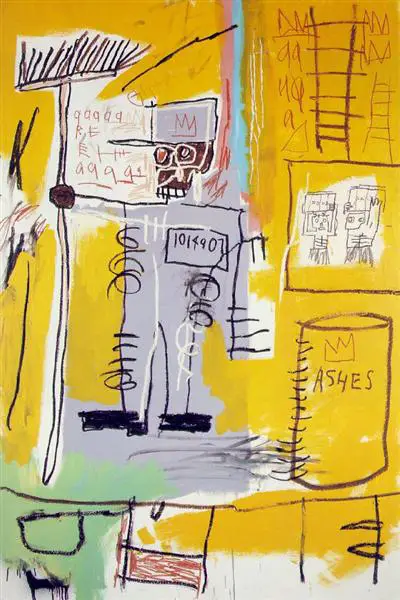Here we find a single figure captured in the style of which we are just so familiar. Single outlines of black oil stick are filled with a single tone. We find perhaps a cleaner, holding a brush high into the air whilst wearing a hat whose colour matches his clothing. The standard crown symbol can be found on his cap, and his features are very loosely displayed, in line with the Neo-Expressionist approach. Basquiat worked in this way for many years and it points to his role as a graffiti artist and also has elements of influence from African art which traditionally has encouraged elongated forms, and abstract details, many centuries before this style started to appear within European art. Whilst being proud on kmowledgeable on the art of his roots, Basquiat also studied traditional European art as well, as shown with his homage to Titian, for example.
Basquiat liked to use just a small palette within his paintings which is entirely typical of contemporary art. In this piece there is a background of predominantly yellow, with the main figure filled in a solid tone of grey which then seeps out around his feet. Other than some green in the bottom left corner, most of the form is actually created from the use of single lines of black oils, added via oil sticks which Basquiat liked to use. Most of his paintings were on large canvases of around two metres in height and the resultant impact was that seeing the artwork in person would uplift us, in a similar way to witnessing some of Mark Rothko's Colour Field paintings. Images such as these online help us to understand the artist's ideas but will never communicate the same emotions as of seeing the original artwork with our own eyes.
The artist was a troubled character who still managed to overcome significant challenges during his own lifetime to establish an impressive reputation. In truth, Basquiat has never been as famous or as loved as he is today and the persistence of his work across social media, as well as a growing interest and exposure to of African American art has allowed many more people to become aware of his career. His work was also often political and seems particularly relevant today, perhaps even more so than during the 1980s when Ashes was produced. This was a point at which he was at his most confident as an artist and had also developed a clear and consistent style.


